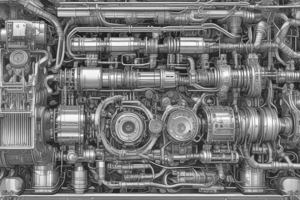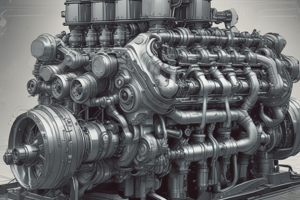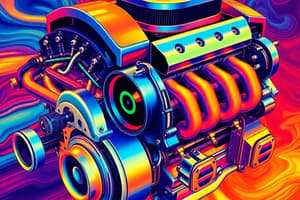Podcast
Questions and Answers
How does a variable-geometry turbocharger maintain optimum aspect ratio at different engine speeds?
How does a variable-geometry turbocharger maintain optimum aspect ratio at different engine speeds?
By altering the geometry of the turbine housing as the engine accelerates, the turbo's aspect ratio can be maintained at its optimum. This allows for reduced lag, a lower boost threshold, and greater efficiency at higher engine speeds.
What is the purpose of an electrically-assisted turbocharger?
What is the purpose of an electrically-assisted turbocharger?
An electrically-assisted turbocharger combines a traditional exhaust-powered turbine with an electric motor to reduce turbo lag.
What is the function of the compressor in a turbocharger system?
What is the function of the compressor in a turbocharger system?
The compressor draws in outside air through the engine's intake system, pressurises it, then feeds it into the combustion chambers (via the inlet manifold).
What is the role of the center hub rotating assembly (CHRA) in a turbocharger?
What is the role of the center hub rotating assembly (CHRA) in a turbocharger?
What additional components are commonly used in conjunction with turbochargers?
What additional components are commonly used in conjunction with turbochargers?
Explain the purpose of a variable-geometry turbocharger and its benefits in engine performance.
Explain the purpose of a variable-geometry turbocharger and its benefits in engine performance.
What is the function of a compressor in a turbocharger system?
What is the function of a compressor in a turbocharger system?
What is the role of the center hub rotating assembly (CHRA) in a turbocharger?
What is the role of the center hub rotating assembly (CHRA) in a turbocharger?
What is the purpose of an electrically-assisted turbocharger?
What is the purpose of an electrically-assisted turbocharger?
How does a ported shroud improve the efficiency of a turbocharger's compressor wheel?
How does a ported shroud improve the efficiency of a turbocharger's compressor wheel?
What type of engines are subject to many of the same operating restrictions as gas turbine engines?
What type of engines are subject to many of the same operating restrictions as gas turbine engines?
Which prominent problem was encountered in the early models of the American Boeing B-29 Superfortress high-altitude bombers?
Which prominent problem was encountered in the early models of the American Boeing B-29 Superfortress high-altitude bombers?
What was the approach of Lancia's Delta S4 in the 1985 and 1986 World Rally Championships?
What was the approach of Lancia's Delta S4 in the 1985 and 1986 World Rally Championships?
In 1849, what did G. Jones of Birmingham, England begin manufacturing?
In 1849, what did G. Jones of Birmingham, England begin manufacturing?
Who patented the design for an air mover for use in blast furnaces and other industrial applications in the United States?
Who patented the design for an air mover for use in blast furnaces and other industrial applications in the United States?
In 1878, who obtained the first patent for a screw-type compressor?
In 1878, who obtained the first patent for a screw-type compressor?
What type of engines have occasionally been used in production cars, such as the 2005-2013 Volkswagen 1.4 litre and the 2017-present Volvo B4204T43/B4204T48 2.0 litre four-cylinder engines?
What type of engines have occasionally been used in production cars, such as the 2005-2013 Volkswagen 1.4 litre and the 2017-present Volvo B4204T43/B4204T48 2.0 litre four-cylinder engines?
In the 1985 and 1986 World Rally Championships, what was the design of Lancia's Delta S4?
In the 1985 and 1986 World Rally Championships, what was the design of Lancia's Delta S4?
What is the efficiency range of roots blowers at high boost levels?
What is the efficiency range of roots blowers at high boost levels?
Which type of supercharger delivers a nearly fixed volume of air per compressor revolution?
Which type of supercharger delivers a nearly fixed volume of air per compressor revolution?
What does the GMC rating system for positive-displacement superchargers measure?
What does the GMC rating system for positive-displacement superchargers measure?
How do dynamic compressors achieve pressure increase?
How do dynamic compressors achieve pressure increase?
Which method is NOT used to drive a supercharger?
Which method is NOT used to drive a supercharger?
What advantage do fuels with a higher octane rating provide in supercharged engines?
What advantage do fuels with a higher octane rating provide in supercharged engines?
What is a potential downside of forced induction, such as supercharging or turbocharging?
What is a potential downside of forced induction, such as supercharging or turbocharging?
In comparison to supercharged engines, what advantage do turbocharged engines generally offer?
In comparison to supercharged engines, what advantage do turbocharged engines generally offer?
In what applications are supercharged engines commonly found due to the importance of throttle response?
In what applications are supercharged engines commonly found due to the importance of throttle response?
During which historical period were mechanically driven superchargers used in aircraft engines?
During which historical period were mechanically driven superchargers used in aircraft engines?
Why were turbochargers useful in high-altitude bombers and some fighter aircraft?
Why were turbochargers useful in high-altitude bombers and some fighter aircraft?
What advantage did superchargers offer in comparison to turbochargers in terms of layout and construction?
What advantage did superchargers offer in comparison to turbochargers in terms of layout and construction?
What distinguishes a supercharger from a turbocharger?
What distinguishes a supercharger from a turbocharger?
When did superchargers begin to be used in car engines?
When did superchargers begin to be used in car engines?
What is the primary advantage of using superchargers in aircraft piston engines?
What is the primary advantage of using superchargers in aircraft piston engines?
Which type of supercharger delivers an almost constant level of boost pressure at all engine speeds?
Which type of supercharger delivers an almost constant level of boost pressure at all engine speeds?
What is the function of the ported shroud in a turbocharger system?
What is the function of the ported shroud in a turbocharger system?
What is the purpose of the center hub rotating assembly (CHRA) in a turbocharger?
What is the purpose of the center hub rotating assembly (CHRA) in a turbocharger?
How does a variable-geometry turbocharger maintain optimum aspect ratio at different engine speeds?
How does a variable-geometry turbocharger maintain optimum aspect ratio at different engine speeds?
What is the role of an electrically-assisted turbocharger?
What is the role of an electrically-assisted turbocharger?
What additional components are commonly used in conjunction with turbochargers?
What additional components are commonly used in conjunction with turbochargers?
Flashcards
Variable-Geometry Turbocharger
Variable-Geometry Turbocharger
A turbocharger that alters the turbine housing's geometry as the engine accelerates to maintain the optimum aspect ratio. This results in reduced lag, a lower boost threshold, and greater efficiency at higher engine speeds.
Forced Induction
Forced Induction
The process of using a mechanical device to force more air into an engine's cylinders, increasing power output.
Supercharger
Supercharger
A type of forced induction system that uses a compressor driven by a belt connected to the engine's crankshaft.
Turbocharger
Turbocharger
Signup and view all the flashcards
Compressor
Compressor
Signup and view all the flashcards
Turbine
Turbine
Signup and view all the flashcards
Center Hub Rotating Assembly (CHRA)
Center Hub Rotating Assembly (CHRA)
Signup and view all the flashcards
Intercooler
Intercooler
Signup and view all the flashcards
Wastegate
Wastegate
Signup and view all the flashcards
Blow-Off Valve (BOV)
Blow-Off Valve (BOV)
Signup and view all the flashcards
Ported Shroud
Ported Shroud
Signup and view all the flashcards
Electrically-Assisted Turbocharger
Electrically-Assisted Turbocharger
Signup and view all the flashcards
Turbo Lag
Turbo Lag
Signup and view all the flashcards
Turbocharger Aspect Ratio
Turbocharger Aspect Ratio
Signup and view all the flashcards
Compressor
Compressor
Signup and view all the flashcards
Twincharged Engine
Twincharged Engine
Signup and view all the flashcards
Roots-type Supercharger
Roots-type Supercharger
Signup and view all the flashcards
GMC Rating
GMC Rating
Signup and view all the flashcards
Dynamic Compressor
Dynamic Compressor
Signup and view all the flashcards
Detonation
Detonation
Signup and view all the flashcards
High Octane Fuels
High Octane Fuels
Signup and view all the flashcards
Knock
Knock
Signup and view all the flashcards
Turbocharger Response
Turbocharger Response
Signup and view all the flashcards
Compressor Surge
Compressor Surge
Signup and view all the flashcards
Surge Damper
Surge Damper
Signup and view all the flashcards
Twincharging
Twincharging
Signup and view all the flashcards
Positive Displacement Supercharger
Positive Displacement Supercharger
Signup and view all the flashcards
Compressor Surge
Compressor Surge
Signup and view all the flashcards
Surge Damper
Surge Damper
Signup and view all the flashcards
Twincharging
Twincharging
Signup and view all the flashcards
Study Notes
Supercharging and Turbocharging Overview
- Roots blowers are about 40-50% efficient at high boost levels, while dynamic superchargers are 70-85% efficient.
- Positive displacement pumps deliver a nearly fixed volume of air per compressor revolution, with the most common type being the Roots-type supercharger.
- The GMC rating system for positive-displacement superchargers is based on the capacity per revolution, e.g., a 6–71 blower pumps 339 cu in (5.6 L) per revolution.
- Dynamic compressors rely on accelerating air to high speed and then exchanging that velocity for pressure by diffusing or slowing it down.
- Common methods of driving a supercharger include belt, direct drive, gear drive, chain drive, variable speed ratio, and electric motors for electric superchargers.
- Fuels with a higher octane rating can resist autoignition and detonation, allowing for increased supercharger boost and engine output.
- Forced induction, such as supercharging or turbocharging, increases the intake air temperature, which can cause pre-ignition or knocking, reducing engine performance.
- Turbocharged engines use energy from exhaust gas, producing more power and better fuel economy than supercharged engines but can suffer from turbo lag.
- Supercharged engines are common in applications where throttle response is crucial, such as drag racing and tractor pulling competitions.
- Aircraft engines used mechanically driven superchargers during World War II due to manufacturing advantages, while turbochargers were mainly employed in American aircraft engines for operational range benefits.
- Turbochargers were useful in high-altitude bombers and some fighter aircraft due to increased high altitude performance and range.
- Turbochargers were comparably heavier when turbocharged, requiring additional ducting of expensive high-temperature metal alloys, while superchargers offered a more compact layout.
Studying That Suits You
Use AI to generate personalized quizzes and flashcards to suit your learning preferences.





